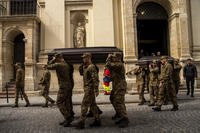
It's begun. A couple of years ago we began hearing quiet discussions on how, as part of the Air-Sea Battle concept, the United States might look to disperse its air forces (lowercase af, not USAF) stationed at its handful of major bases in the western Pacific in the event of a major conflict with China. Doing so would make it more difficult for China to wipe out entire squadrons sitting on the ground with surprise attacks from its long range ballistic missiles (think the DF-21D carrier killers but designed to hit ground targets instead of ships).
A key component of this plan is the refurbishment of long-abandoned World War II airfields scattered across the Pacific. These fields would serve as pretty bare bones facilities that American aircraft could disperse to if a conflict seemed imminent (similar to the way Strategic Air Command's Cold War dispersal base concept worked).
It looks like the Marine Corps has begun practicing how to put such a plan into action. Last month, Marines refurbished the 8,000-foot "Baker" runway at the abandoned -- and historic -- North Field air base on the island of Tinian, and installed aircraft carrier-like arresting gear on the runway of the island's lightly-used West Field. Naturally, this was followed up by Marine Corps F/A-18D Hornets from nearby Guam performing arrested landings on West Field, as shown in the picture above.
The exercise, called Geiger Fury '12, was designed to put the theory of operating from bare bones Pacific bases into practice. Or, as one of the official Marine Corps press release on the events says, "the purpose of Exercise Geiger Fury is to execute and assess combined expeditionary operations in the Pacific." You're welcome for the translation.
Keep in mind that North Field at Tinian -- with its four parallel runways, Able, Baker, Charlie and Dog -- was one of the most important U.S. airfields in the Pacific during World War II. It's the base where the B-29s Enola Gay and Bocks Car took off from to drop atomic bombs on Hiroshima and Nagasaki, effectively ending the war.
Click through the jump to watch videos of F/A-18s landing at night on West Field and the Marines rebuilding parts of North Field and setting up a Forward Operating Base.







